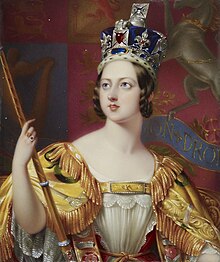Rundell and Bridge
| Industry | Manufacturing |
|---|---|
| Founded | 1787 in London, England |
| Founders | Philip Rundell and John Bridge |
| Headquarters | London , England |
Key people |
|
| Products | goldsmiths' work, jewellery |
Rundell & Bridge were a London firm of jewellers and goldsmiths formed by Philip Rundell (1746–1827)[1] and John Bridge (baptized 1755–1834).[2]
History


When Edmond Walter Rundell, nephew of Philip Rundell, was admitted as a partner in 1804, the firm's name changed to Rundell, Bridge & Rundell.
The firm was appointed as one of the goldsmiths and jewellers to the king in 1797 and Principal Royal Goldsmiths & Jewellers in 1804, and the firm held the Royal Warrant until 1843.[6]
Amongst its employees were the well-known artists John Flaxman and Thomas Stothard, who both designed and modelled silverware. Directing their workshops from 1802 were the silversmith Benjamin Smith and the designer Digby Scott; and in 1807, Paul Storr, the most celebrated English silversmith of the period, took charge, withdrawing from the firm in 1819 to establish his own workshops.[7]
The Royal Goldsmiths served four monarchs:
Works

After the
In 1830–1831, the firm created the
General Mining Association
Rundell, Bridge & Rundell formed the General Mining Association (G.M.A.) in 1827 and opened a colliery in Sydney Mines, Cape Breton, Nova Scotia, Canada the same year and a second colliery in nearby Dominion (then called Lingan and subsequently Bridgeport) in 1830. The G.M.A. operated coal mines and built shipping piers and railways in Cape Breton until it sold its eastern Cape Breton County holdings to the Dominion Coal Company by 1894 and retained its Sydney Mines operations until selling to the Nova Scotia Steel and Coal Corporation in 1900.[10]
Bibliography
- Fox, George, (1843), History of Rundell, Bridge and Rundell (Manuscript of a history of the firm written by a long-time employee.) Held at the Baker Library, Harvard Business School. OCLC 229894299
- Hartop, Christopher, with foreword by OCLC 61424651
- Hartop, Christopher (October 2015), Art in Industry: The Silver of OCLC 927983072
- Lovett, Robert W. (September 1949). "Rundell, Bridge and Rundell – An Early Company History". Bulletin of the Business Historical Society. 23 (3): 152–162. JSTOR 3111183.
References
- user-generated source]
- user-generated source]
- ^ Quotation from a promotional colour print issued by Rundell's of the Imperial Crown, reproduced in Hartop, Royal Goldsmiths, p. 143.
- ^ Hartop, Royal Goldsmiths, "Chronology", p. 12.
- ^ Hartop, Royal Goldsmiths, "Chronology", p. 13.
- ^ Hartop, Royal Goldsmiths, "Chronology", pp. 12–13.
- ^ Hartop, Royal Goldsmiths, "Chronology", pp. 12–13.
- The Art Bulletin, Vol. 83, No. 1, (March 2001), pp. 48–71.
- ^ "Who Pinched the Irish Crow Jewels?".
- ^ Charles William Vernon, Cape Breton, Canada, at the Beginning of the Twentieth Century: A Treatise of Natural Resources and Development (Toronto and New York: Nation Publishing Company, 1903), pp. 172–8. Leonard Stephenson, Dominion, NS, 1906–1981, pp. 8–9.
